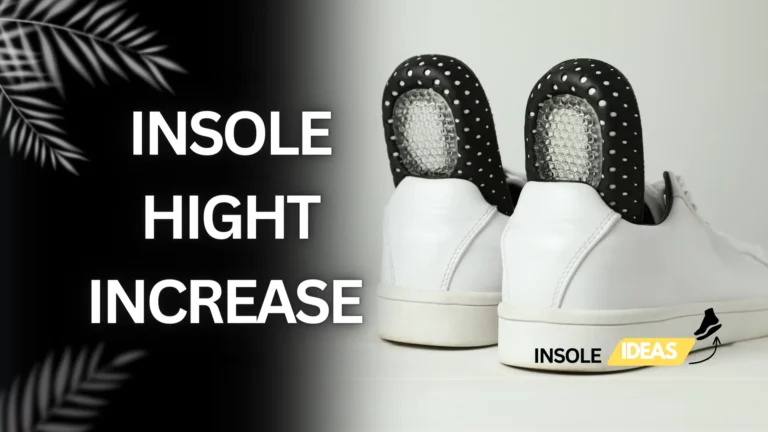A Comprehensive Guide for Footwear Care
Introduction
Although shoe maintenance is sometimes disregarded, it is essential to preserving the comfort and health of our feet as well as the lifespan of our shoes. In this comprehensive guide, we’ll delve into the significance of insoles in enhancing footwear comfort and address common concerns regarding insole cleanliness. Proper hygiene not only contributes to a more pleasant shoe-wearing experience but also plays a vital role in overall foot health.
Importance of Insoles in Footwear Comfort
Insoles serve as the foundation of comfort in footwear, providing support, cushioning, and stability. They help distribute pressure evenly, reduce impact on the feet, and enhance the overall fit of the shoes. Without proper insoles, shoes may lack the necessary support, leading to discomfort, fatigue, and even potential foot problems. Understanding and appreciating the role of insoles is the first step toward effective footwear care.
Common Concerns about Insole Cleanliness
Maintaining clean insoles is not only about aesthetics; it directly affects the hygiene of our feet. Dirty insoles can harbor bacteria, fungi, and unpleasant odors, creating an environment conducive to foot ailments. We’ll explore the common concerns associated with dirty insoles and how addressing these concerns is integral to promoting foot health.
Necessity of Maintaining Hygiene for Overall Foot Health
The health of our feet is interconnected with the cleanliness of our footwear. Neglecting hygiene can lead to conditions such as athlete’s foot, toenail fungus, and other infections. This section emphasizes the importance of prioritizing foot hygiene and offers insights into how regular insole care contributes to overall foot health.
Why Insoles Get Dirty
Understanding the factors contributing to insole dirtiness is crucial for effective maintenance. Let’s explore these factors in detail.
Daily Wear and Tear
The constant friction and pressure exerted on insoles during daily activities contribute significantly to their wear and tear. As we move, the insoles absorb the impact, protecting our feet, but in the process, they accumulate dirt, debris, and dead skin cells. Recognizing the impact of daily wear and tear on insoles is essential for devising a proper cleaning routine.
Sweat and Moisture Absorption
Feet are natural sweat producers, and when enclosed in shoes, this moisture is absorbed by the insoles. Sweat and heat together provide the perfect conditions for the development of fungus and bacteria. Acknowledging the role of sweat in insole dirtiness underscores the importance of proper ventilation and moisture management.
Environmental Factors
The external environment also contributes to the dirtiness of insoles. Dust, dirt, and particles from various surfaces can find their way into our shoes, settling on the insoles. Awareness of how environmental factors impact insole cleanliness guides us in adopting preventive measures and cleaning practices.
Types of Insoles
Achieving the appropriate degree of comfort and cleanliness requires choosing the correct kind of insoles. Let’s explore the various materials used in insoles.
Foam
Foam insoles, known for their softness and cushioning, are a popular choice. However, their porous nature makes them susceptible to dirt and moisture buildup. Proper care, including regular cleaning and adequate ventilation, is essential to preserve the effectiveness of foam insoles.
Gel
Gel insoles provide excellent shock absorption and support. While they are durable, they are not immune to dirt accumulation. Understanding the cleaning requirements of gel insoles ensures their continued performance and longevity.
Leather
Leather insoles are prized for their durability and breathability. Despite their resistance to odors, they are susceptible to dirt and moisture. Regular cleaning and conditioning are imperative to maintain the quality and hygiene of leather insoles.
Odor-Fighting Insoles
Some insoles come equipped with features designed to combat odors, such as antimicrobial treatments or activated charcoal layers. While these features offer additional protection, regular cleaning remains a crucial step in ensuring the ongoing effectiveness of odor-fighting insoles.
Why Insoles Get Dirty
Insoles play a pivotal role in providing comfort and support to our feet, acting as the interface between our feet and the shoes. Over time, however, these unsung heroes can become a breeding ground for dirt and bacteria. Understanding the factors contributing to insole dirtiness is crucial for maintaining overall foot health.
Daily Wear and Tear
The primary cause of filthy insoles is normal wear and tear from constant use. Our feet frequently rub against the insoles while we run, stroll, or do other activities, which causes dirt, dead skin cells, and other debris to accumulate. This not only affects the hygiene of the insoles but can also impact their cushioning and support capabilities.
Sweat and Moisture Absorption
Another significant factor contributing to insole dirtiness is the absorption of sweat and moisture. Feet contain numerous sweat glands, and when enclosed in shoes, they create a humid environment ideal for bacteria and fungi growth. The insoles, acting as a sponge, absorb this moisture, providing an ideal breeding ground for unpleasant odors and microbial activity.
Environmental Factors
The environment in which we wear our shoes also plays a role in insole cleanliness. Dust, dirt, and external particles can find their way into our shoes and settle on the insoles. This is particularly true in outdoor settings or areas with poor air quality. Additionally, the type of flooring we walk on, whether it’s clean or dirty surfaces, can impact the amount of debris that accumulates on the insoles.
Types of Insoles
Understanding the different materials used in insoles is essential for choosing the right type that aligns with your comfort and hygiene needs.
Foam
Foam insoles are popular for their cushioning properties. They provide a soft and comfortable base for the feet. However, due to their porous nature, foam insoles can be more prone to accumulating dirt and moisture. Regular cleaning and proper ventilation are essential to maintain their effectiveness.
Gel
Gel insoles are designed to offer superior shock absorption and support. These insoles are resilient and durable, but they too can harbor dirt and bacteria. Cleaning gel insoles is crucial to prevent the growth of microbes and to ensure their longevity.
Leather
Leather insoles are renowned for being breathable and long-lasting. While they resist odor to some extent, they are not immune to dirt and moisture. Regular cleaning and conditioning are necessary to preserve the quality of leather insoles and prevent any hygiene-related issues.
Odor-Fighting Insoles
Some insoles come equipped with special features to combat odors. These may include antimicrobial treatments or activated charcoal layers. While these features help in minimizing the growth of odor-causing bacteria, regular maintenance and cleaning remain important for optimal performance.
Can Insoles Be Washed?
Maintaining clean insoles is essential for overall foot hygiene and comfort. However, when it comes to cleaning, not every insole is made equal. Let’s delve into the factors that determine whether insoles can be washed and explore tips for identifying washable options.
Discussing Washable vs. Non-Washable Insoles
The first consideration is to distinguish between washable and non-washable insoles. Washable insoles are typically made from materials that can withstand water and cleaning agents without compromising their structure. On the other hand, non-washable insoles may have materials that can break down or lose effectiveness when exposed to water. Checking the manufacturer’s instructions is crucial in making this determination.
Tips for Identifying Washable Insoles
Identifying washable insoles requires a close examination of the materials used. In general, insoles made of materials like foam, gel, or synthetic fibers are more likely to be washable. Leather insoles, however, often require special care and may not be suitable for washing. Manufacturers often provide information on washability on the packaging or in product descriptions, so it’s essential to look for these details before attempting to clean the insoles.
Importance of Following Manufacturer Instructions
Manufacturers provide specific care instructions for a reason. Following these instructions ensures that you clean your insoles effectively without causing damage. Ignoring these guidelines may lead to deformation, reduced support, or a shortened lifespan for the insoles. Taking the time to understand and adhere to the manufacturer’s recommendations is a crucial step in maintaining the integrity of your insoles.
How to Wash Washable Insoles
For those fortunate enough to have washable insoles, proper cleaning is key to preserving their functionality and hygiene. Let’s explore a step-by-step guide for cleaning washable insoles, covering aspects from removal to drying methods.
Step-by-Step Guide for Cleaning Washable Insoles
1. Removing Insoles from Shoes: To begin, take out the insoles from your shoes very gently. This guarantees that you can reach every region and clean them completely.
2. Hand Washing vs. Machine Washing: Most washable insoles can be cleaned by hand. Use warm water and a light soap or detergent. Make use of a gentle brush or towel to gently clean the insoles. Avoid harsh chemicals or excessive scrubbing to prevent damage. Some insoles may also be machine washable, but it’s crucial to check the manufacturer’s instructions before doing so.
3. Drying Methods: After washing, allow the insoles to air dry completely. Direct heat sources, such as hair dryers and radiators, should be avoided since too much heat might harm some materials. Placing them in a well-ventilated area ensures that they dry thoroughly without losing their shape or functionality.
Removing Insoles from Shoes
Taking the time to remove insoles from your shoes before cleaning serves multiple purposes. It allows for a more thorough cleaning process, ensuring that every inch of the insole is addressed. It also gives you a chance to check the shoes for any wear or damage that could require repair.
Hand Washing vs. Machine Washing
The manufacturer’s particular care recommendations will determine whether to wash by hand or in a machine. Hand washing allows for more controlled and gentle cleaning, minimizing the risk of damage. Machine washing may be suitable for some insoles, but it’s essential to use a delicate cycle and follow guidelines to avoid potential issues.
Drying Methods
Proper drying is as crucial as the cleaning process. Air drying is the safest method for washable insoles. Placing them in a well-ventilated area allows moisture to evaporate naturally. Avoid using heat sources like radiators or direct sunlight, as this can lead to deformation or damage to certain materials. Patience during the drying process ensures that your insoles are ready to provide optimal support and comfort once again.
Cleaning Non-Washable Insoles
Not all insoles are designed to withstand traditional washing methods. Non-washable insoles require alternative cleaning techniques to maintain hygiene without compromising their structure or effectiveness. Let’s explore options for cleaning non-washable insoles.
Alternatives for Non-Washable Insoles
For insoles labeled as non-washable, alternative cleaning methods become essential. One effective approach is to use disinfectant sprays specifically designed for insoles. These sprays help eliminate bacteria and odors without exposing the insoles to excessive moisture. Selecting a cleaning solution that is appropriate for the insole material is essential to guaranteeing thorough cleaning without causing harm.
Using Disinfectant Sprays
Disinfectant sprays provide a convenient and efficient way to clean non-washable insoles. These sprays often contain antimicrobial agents that combat bacteria and fungi, addressing the primary causes of odors and hygiene issues. To use, simply spray a suitable amount onto the insoles, following the product instructions, and allow them to air dry. This method is especially useful for insoles with fabric or foam materials.
Wiping with Damp Cloth
For insoles that can tolerate minimal moisture, wiping with a damp cloth is a viable option. Use a cloth that is not overly wet to avoid saturating the insoles. Gently wipe the surface, paying attention to areas with visible dirt or stains. This method helps remove surface debris and refresh the insoles without the need for submerging them in water.
Sun Exposure for Odor Removal
Sun exposure can be a natural and effective method for removing odors from non-washable insoles. Place the insoles in direct sunlight for a few hours, allowing the UV rays to help kill bacteria and eliminate odors. This method is particularly useful for insoles that cannot be washed or exposed to moisture.
Maintaining Insole Hygiene
Beyond cleaning, maintaining consistent insole hygiene is crucial for long-term foot health and comfort. Let’s explore how to establish a regular cleaning routine, tips for preventing excessive dirt and odor, and the importance of rotating multiple pairs of insoles.
Regular Cleaning Routine for Insoles
In order to stop the accumulation of grime, bacteria, and smells, it is essential to establish a regular cleaning schedule. Even washable insoles benefit from periodic cleaning to maintain their effectiveness. Set a schedule based on your usage frequency, and incorporate cleaning into your overall footwear care routine. This proactive approach ensures that your insoles stay fresh and hygienic.
Tips for Preventing Excessive Dirt and Odor
Preventing excessive dirt and odor starts with good foot hygiene. Before putting on shoes, make sure your feet are dry and clean. To reduce the amount of perspiration absorbed, think about wearing socks that wick away moisture. Additionally, rotating your shoes and insoles allows each pair to air out between wears, reducing the likelihood of bacterial growth and unpleasant odors.
Importance of Rotating Multiple Pairs of Insoles
Rotating between multiple pairs of insoles is a simple yet effective strategy for maintaining insole hygiene. By allowing each pair to rest between uses, you reduce the accumulation of moisture and bacteria. This practice not only extends the life of your insoles but also contributes to a healthier and more comfortable overall footwear experience. Consider investing in multiple pairs of insoles to support this rotation and ensure optimal foot hygiene.
“Footwear Hygiene Tips”
Maintaining footwear hygiene goes beyond just cleaning insoles. It involves practices like regularly airing out shoes, choosing moisture-wicking socks, and ensuring proper shoe storage. These tips collectively contribute to a healthier environment for your feet, preventing the growth of bacteria and reducing the risk of foot-related issues.
“Cleaning Tips for Insoles”
While cleaning insoles is crucial, it’s equally important to know the right techniques. Gentle cleaning with mild soap, using disinfectant sprays for non-washable insoles, and proper drying methods all play a role. These tips ensure effective cleaning without compromising the integrity of the insoles, promoting longevity and hygiene.
“Choosing the Right Insole Material”
The material of insoles significantly impacts their performance and maintenance. Understanding the characteristics of materials like foam, gel, leather, or odor-fighting insoles helps in making informed choices. Each material has its benefits and care requirements, and selecting the right one aligns with your comfort preferences and hygiene needs.
“Odor Removal for Shoes”
Shoe odor is a common concern, often stemming from bacteria growth and moisture accumulation. Exploring effective odor removal techniques, such as using activated charcoal, baking soda, or exposing shoes to sunlight, provides insights into addressing this issue. Combining these methods with proper insole care contributes to a fresher overall footwear experience.
Conclusion
In conclusion, the cleanliness of insoles is a crucial aspect of overall foot health. By emphasizing the importance of maintaining clean insoles, we pave the way for a more comfortable and hygienic experience with our footwear. Let’s recap the key points and encourage readers to establish a routine for maintaining foot hygiene.
Recap of the Importance of Insole Cleanliness
Clean insoles contribute not only to the longevity of shoes but also to the health and comfort of our feet. Regular cleaning prevents the buildup of dirt, bacteria, and odors, ensuring that insoles continue to provide the necessary support and cushioning. Prioritizing insole cleanliness is an investment in both foot health and overall well-being.
Encouraging Readers to Establish a Routine for Maintaining Foot Hygiene
Establishing a routine for maintaining foot hygiene, including regular insole cleaning, is a proactive step toward preventing foot-related issues. Encourage readers to incorporate these practices into their daily or weekly routines, making foot care a habit that contributes to long-term comfort and health.
Closing Thoughts on the Impact of Clean Insoles on Overall Foot Health
In the grand scheme of foot health, clean insoles play a vital role. They contribute to preventing conditions such as athlete’s foot, toenail fungus, and unpleasant odors. Closing thoughts emphasize the interconnectedness of foot hygiene and overall well-being, highlighting that clean insoles are a fundamental part of comprehensive foot care. By prioritizing insole cleanliness, individuals can enjoy a more pleasant and healthier experience with their footwear.
Yes, wash by hand according to the manufacturer’s instructions using a little soap and water. Thoroughly air-dry before re-inserting.
Examine the care directions; certain items may be gently machine washed, while others might break down. Review the advice provided by the manufacturer.
Every couple weeks or whenever smells appear, clean. Individual frequency is determined by usage and taste. Insole longevity is increased with regular cleaning.
Steer clear of it. Hand washing helps to protect fragile items. For gel or orthopaedic insoles to stay intact, adhere to the recommended maintenance guidelines.
Sprinkle with baking soda, then let it overnight to draw moisture and eliminate smells. Continual prevention can be achieved by using antimicrobial sprays or insoles. Upkeep on a regular basis maintains insoles new.



